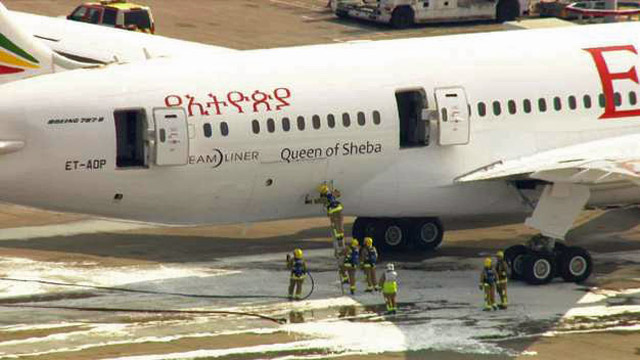Investigators are seeking assurances that aircraft systems powered by lithium batteries are adequately protected against short-circuit, after formally attributing the Ethiopian Airlines Boeing 787 ground fire to thermal runaway in the emergency locator transmitter.
The aircraft sustained serious damage in the fire which broke out while it was parked, empty, on a remote stand at London Heathrow on 12 July 2013.
UK Air Accidents Investigation Branch inquiries have determined that the extent of the damage to the transmitter, combined with the absence of neighbouring systems capable of ignition, have “identified [it] as the source of the fire”.
The blaze in the ELT, a Honeywell Rescu 406AFN model, resulted from uncontrolled energy release, probably from an external short circuit in combination with early depletion of a single cell in the lithium manganese dioxide battery.
Investigators believe the short-circuit resulted from battery wires being crossed and trapped under the ELT battery compartment’s cover-plate when the battery was last accessed.

AP/Press Association
The ELT battery is fitted with a ‘positive temperature coefficient’ protective device, which is designed to protect the battery circuit from adverse external short-circuits by detecting high temperatures and limiting discharge currents to a safe level.
But the inquiry found that this device “did not provide” the level of protection intended, and that certain characteristics of the device, notably its resetting behaviour, was “not well understood” during the battery design.
Investigators examined five potential failure scenarios in which short-circuit defences could be defeated, four of which could emerge despite the presence of a fully-functional protective device.
The trapped wires in the ELT compromised the seal of the battery cover-plate, allowing hot gas and flames to affect the 787’s composite fuselage and initiate a “slow-burning fire” in the aft fuselage crown, says the inquiry.
Absence of cell segregation in the battery enabled the initial thermal runaway to propagate to remaining cells.
Insulation blankets close to the ELT allowed enough heat to remain close to the fuselage to maintain the fire, and it spread through the space between the blankets and the aircraft skin. But it remained a low-energy blaze and there was no evidence of accelerating combustion or flashover.
Investigators have already issued several safety recommendations in the wake of the event, but have released another eight, mainly centred on ensuring acceptable levels of protection against short-circuit, unbalanced discharge and heat dissipation in systems powered by lithium batteries.
Source: Cirium Dashboard


























